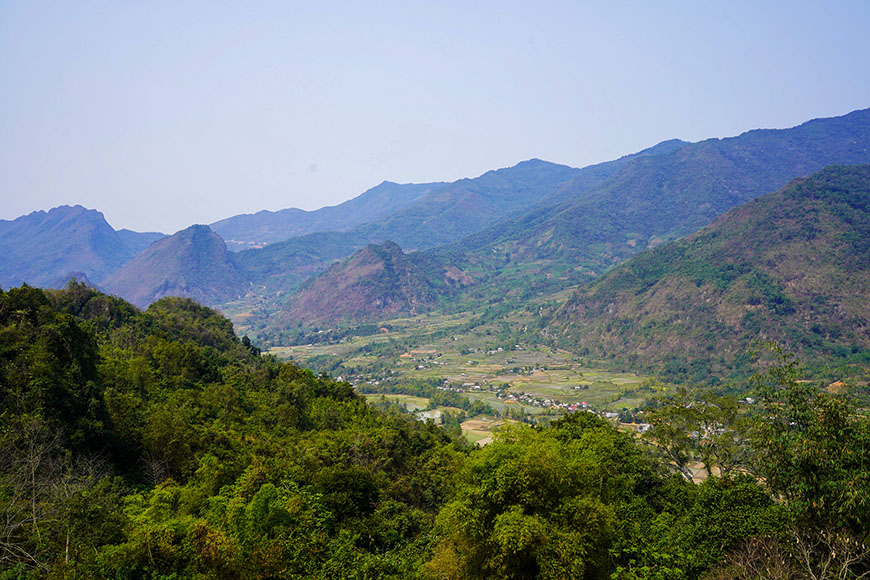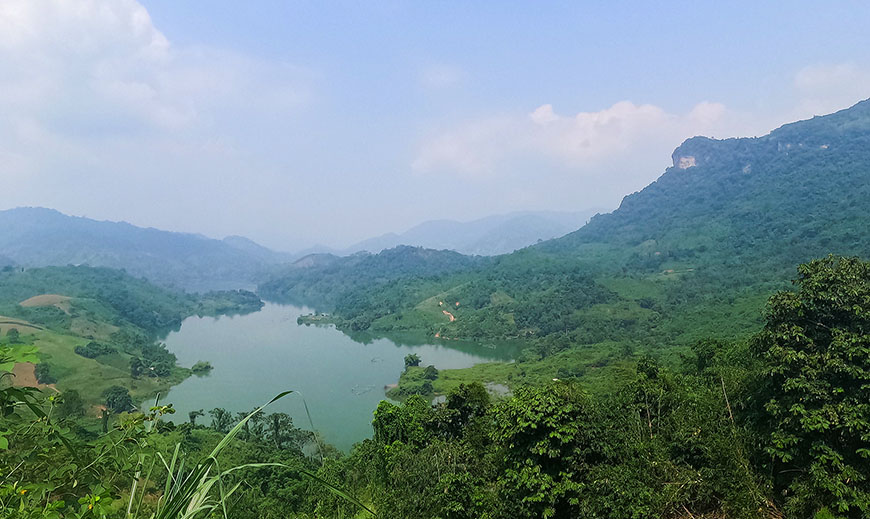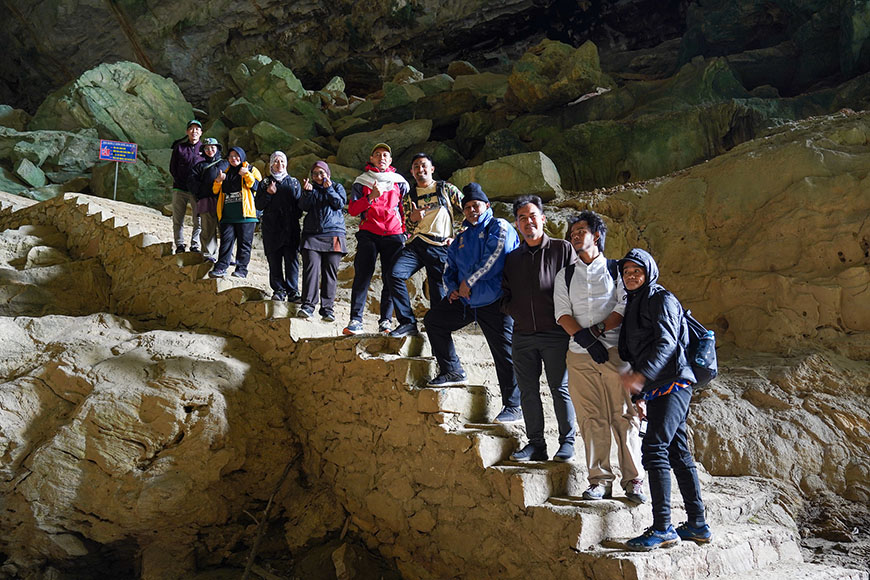Located in the mountainous
province of Bac Kan, in northern Vietnam,
Ba Be National Park is a true gem of ecotourism. This exceptional site, renowned for its biodiversity and enchanting landscapes, attracts thousands of visitors each year.
However, despite its immense potential, the park faces various challenges in harnessing its tourist attractions. Let's explore the current state of
ecotourism in Ba Be, highlighting its strengths and weaknesses, as well as the issues and prospects for its future development.
 Ba Be National park, a true jewel of Bac Kan Province - Mr Linh's Adventures
Ba Be National park, a true jewel of Bac Kan Province - Mr Linh's AdventuresBrief historical overview
Established in 1992,
Ba Be National Park covers an area of 10,048 hectares, encompassing seven communes in the districts of Ba Be and Cho Don. For over twenty years, local authorities have been committed to developing ecotourism in the park, pursuing a dual objective: preserving this natural treasure while providing visitors with an authentic and enriching experience.
Renowned for its limestone mountains that harbor rich biodiversity, the park is a sanctuary for
over 1,200 plant species and 600 animal species, some of which are rare or endangered, such as the white-cheeked gibbon and the Asian black bear. Its ecological value was internationally recognized in 1995 when it was classified among the 20 exceptional freshwater lakes in the world requiring protection. Subsequently, it was designated as an ASEAN Heritage Park in 2003 and recognized as an internationally important wetland under the Ramsar Convention in 2011.
Today, around ten villages welcome travelers, offering
homestay accommodations, outdoor activities such as hiking, boat rides on the peaceful lake waters, exploration of fascinating caves, and the discovery of delicious local cuisine. The economic benefits of this approach directly support local communities, which play an active role in park management and protection.
 Peaceful Ba Be lake - Mr Linh's Adventures
Peaceful Ba Be lake - Mr Linh's AdventuresStrengths and weaknesses of ecotourism in Ba Be
One of the main strengths of ecotourism in Ba Be lies undoubtedly in its biodiversity, flourishing amidst wild and preserved beauty. Here, primary and secondary forests alternate with wetlands, rivers, and waterfalls, creating a peaceful setting dominated by limestone mountains reflecting in the calm waters of Ba Be Lake.
The lake itself, Vietnam's largest natural freshwater lake, is a rare curiosity. It is one of the few lakes located on a limestone mountain that remains constantly fed, even during the dry season. This uncommon geological phenomenon makes it a site of global importance, classified among the 20 essential natural lakes to protect.
Furthermore, international accolades awarded to the park, such as its status as an ASEAN Heritage Park and an internationally important wetland, reinforce and legitimize its ecotourism appeal. Pleasant weather throughout the year also constitutes a significant advantage for the park. However, these strengths would be meaningless without the warm hospitality of the local populations. The presence of three distinct ethnic minority groups – Tay, Dao, and H'mong – makes Ba Be an ideal place for ecotourism, wellness retreats, educational visits, and cultural exploration.
 Rural life in Ba Be National Park - Mr Linh's Adventures
Rural life in Ba Be National Park - Mr Linh's Adventures
Nevertheless, the rapid development of tourism also poses certain challenges, such as waste management, overcrowding at certain sites, and the preservation of traditional culture. Authorities must therefore find a delicate balance between economic development and environmental protection.
Despite attracting tens of thousands of visitors each year, both for tourism and research, the park faces difficulties in fully leveraging its ecotourism potential. A lack of investment hinders the development of infrastructure and tourist services. Furthermore, despite efforts made, there is a lack of tourism management expertise, complicating the planning and effective implementation of tourism projects. This expertise gap often accompanies incomplete environmental and social assessments, threatening the long-term sustainability of tourism activities.
 Delegation of Malaysian scientists visits Ba Be National Park - Mr Linh's Adventures
Delegation of Malaysian scientists visits Ba Be National Park - Mr Linh's AdventuresIssues and prospects of ecotourism in Ba Be
For the future, the main challenge will be to consolidate a virtuous ecotourism model that fully benefits local communities while preserving the natural and cultural riches of the park. Several avenues are emerging:
- ✓Environmental Conservation: Tourism development must balance with the need to protect the environment and the park's unique biodiversity.
- ✓Local Economic Development: Ecotourism can be a powerful economic driver for local communities, but it is essential to ensure equitable sharing of benefits.
- ✓Infrastructure and Accessibility: Improving roads and tourist infrastructure is crucial to attract more visitors and facilitate their stay.
Ba Be National Park is home to a rich flora diversity - Mr Linh's Adventures
The Bac Kan province has approved a master plan for the development of ecological tourism in the park for the period 2021-2030. This ambitious plan aims to welcome 150,000 visitors per year, including 10% international tourists, and to create 800 permanent jobs by 2025. In the longer term, the goal is to secure between six and eight investment projects in forest environmental leases and to welcome 450,000 visitors per year, including 20% international tourists, by 2030. The main idea is to promote tourist stays of more than three days to generate stable employment while maintaining strict standards for environmental protection and nature conservation.
Ecotourism in Ba Be National Park: A vision for the future
The development of tourist infrastructure in Ba Be is guided by a sustainable approach, seeking to balance economic growth with environmental preservation and the valorization of local cultures.
Ba Be National Park, a unique but fragile destination for ecotourism - Mr Linh's Adventures
In this ecotourism vision, it is crucial to remain vigilant about potential risks. Excessive reliance on tourism could make the local economy vulnerable to market fluctuations and global crises, highlighting the importance of diversifying revenue sources. Similarly, if tourist infrastructures are not seamlessly integrated into the local community, this could lead to inequalities between those who bear the costs and those who benefit from the economic returns. It is therefore essential to establish mechanisms to redistribute some of the benefits to the community. Finally, poorly managed tourist influx could exert excessive pressure on the local environment and lead to a dilution of the cultural values of communities. It is therefore essential to anticipate and manage these impacts to preserve the cultural authenticity and environmental integrity of the park.
Let us be optimistic: with its unique assets, Ba Be National Park has the potential to become a flagship ecotourism destination in Vietnam. An exceptional opportunity to reconcile economic development and environmental protection!